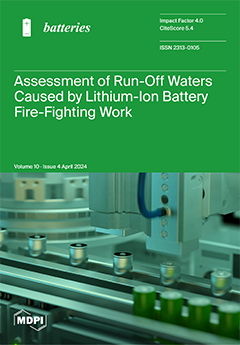Open AccessReview
Towards to Battery Digital Passport: Reviewing Regulations and Standards for Second-Life Batteries
by
Carlos Antônio Rufino Júnior, Eleonora Riva Sanseverino, Pierluigi Gallo, Daniel Koch, Sergej Diel, Gero Walter, Lluís Trilla, Víctor J. Ferreira, Gabriela Benveniste Pérez, Yash Kotak, Josh Eichman, Hans-Georg Schweiger and Hudson Zanin
Viewed by 1185
Abstract
Greenhouse gas emissions from transportation harm the environment. In response to these environmental concerns, numerous countries encourage the adoption of electric vehicles (EVs) as a more environmentally friendly option than traditional gasoline-powered vehicles. Advances in battery technology have made batteries an alternative solution
[...] Read more.
Greenhouse gas emissions from transportation harm the environment. In response to these environmental concerns, numerous countries encourage the adoption of electric vehicles (EVs) as a more environmentally friendly option than traditional gasoline-powered vehicles. Advances in battery technology have made batteries an alternative solution for energy storage in stationary applications and for electric mobility. Reduced lithium-ion batteries (LIBs) production costs due to economies of scale, electrode material and cell design developments, and manufacturing process improvements have driven this success. This trend is expected to increase the number of LIBs on the market that may be discarded in the environment at the end of their useful life if more sustainable alternatives are not technologically mature. This coming environmental concern can be mitigated by collecting wasted EV batteries, reconfiguring them, and reusing them for applications with less stringent weight, performance, and size requirements. This method would extend battery life and reduce environmental effects. The present work investigates the main regulatory structures of the second-life battery industry that require rules, technical standards, and laws. To achieve this objective, a systematic review was carried out following a strict protocol that includes identifying relevant studies, extracting data and information, evaluating, and summarizing information. This paper explains the primary rules and technical standards governing the second-life battery business. The findings highlight the need for universities, research institutions, and government agencies to evaluate the second-life battery industry objectively. This would enable the creation of new technological regulations and laws for this burgeoning industry.
Full article
►▼
Show Figures





